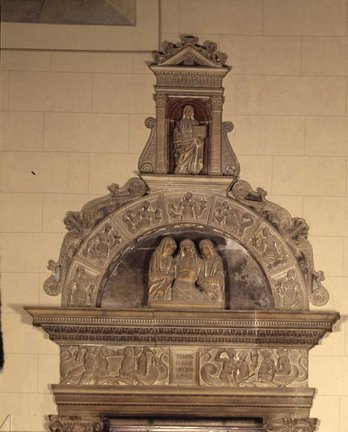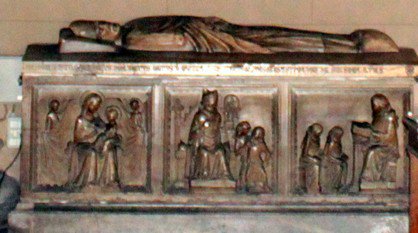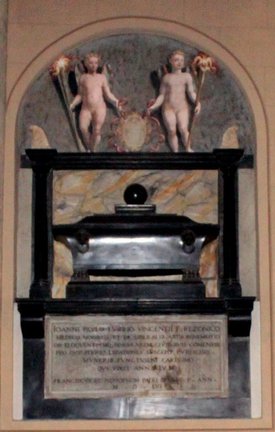Campata destra 3
Il santo scolpito nella chiave di volta è l’evangelista San Matteo, che regge un libro e il cartiglio che lo identifica.
La porta laterale scolpita dai Rodari reca l’iscrizione “Tempio di Maria Vergine” e la data 1509.
A sinistra della porta l’Epigrafe a trittico riporta un elenco di benefattori.
Seguono due tombe sovrapposte: sotto il sarcofago del vescovo Bonifacio da Modena , sopra la tomba Rezzonico .
Nella vetrata la Visita di Maria ad Elisabetta e la Presentazione di Gesù al tempio sono opera di Giuseppe Bertini (1857-1858).
L’arazzo con lo Sposalizio della Vergine fu realizzato a Ferrara nel 1569 da Luigi Karcher su cartone di Camillo e Sebastiano Filippi per il Capitolo del Duomo che probabilmente lo volle ispirato alla tela di Gaudenzio Ferrari nel Duomo (quarta campata nord).
Si osservi il fregio sopra la porta. La Battaglia marina di figure mitologiche è ripresa da incisioni di Andrea Mantegna: a sinistra stanno per prendersi “a pesci in faccia” due personaggi con orecchi da satiro che cavalcano figure mostruose con teste di cavallo e corpo di pesce; a destra si affrontano, brandendo bastoni e un teschio equino, due coppie delle quali le figure maschili hanno testa e busto umano, zampe equine e coda di fantastici mostri marini.
Nella lunetta è scolpito il gruppo del Cristo in Pietà fra Maria e Giovanni. Attorno sette riquadri ciascuno con una figura di donna che reca una lampada: le due in basso hanno la lampada spenta, le altre cinque la tengono accesa secondo la parabola evangelica (Matteo, 25, 1-13) delle Vergini Sagge (reggono infatti la scritta V(IRGO) PRUDENS) che attendono lo Sposo (Cristo), raffigurato alla sommità della lunetta nella nicchia.
Il riferimento alla parabola fu probabilmente indotto dalla dedicazione della campata all’evangelista Matteo, raffigurato, assai prima della realizzazione del portale, nella chiave di volta. Il tema dello sposalizio tra Cristo e la Chiesa trova corrispondenza nell’iscrizione TEMPLV(M) / MARIAE / VIRGINIS.
Fuori e attorno all’arcata motivi di delfini affrontati sono un simbolo di Cristo: dotato di doppia natura (divina ed umana) come si riteneva fosse il delfino, capace di stare dentro ma anche fuori dell’acqua e salvatore di uomini.
Il sarcofago del vescovo Bonifacio da Modena (1340-1352) con iscrizioni gotiche (1347), opera di un anonimo scultore campionese, proviene dalla precedente cattedrale di S. Maria Maggiore dove doveva stare in una cappella che il vescovo aveva dedicato al santo vescovo Geminiano, patrono di Modena, sua patria. Sul coperchio la figura giacente del vescovo. Nelle formelle: Madonna in trono col Bambino fra angeli, S. Geminiano mentre compie un esorcismo e come maestro di scuola.
Sopra sta il Monumento funebre d’impianto umanistico (sarcofago inscritto in un arco) del 1556 (fronteggia la tomba Giovio di pari data).
Fu dedicato dai figli Francesco e Senofonte al padre Giovan Paolo Della Torre di Rezzonico figlio di Vincenzo, medico e benemerito delle arti liberali, che per singolare eloquenza ricoprì diversi incarichi pubblici e di rappresentanza cittadina. L’ispirazione classica è anche nei due angioletti affrescati che reggono lo stemma e fiaccole accese (simbolo di vita eterna), versione cristiana dei geni funerari pagani con la fiaccola rovesciata.






